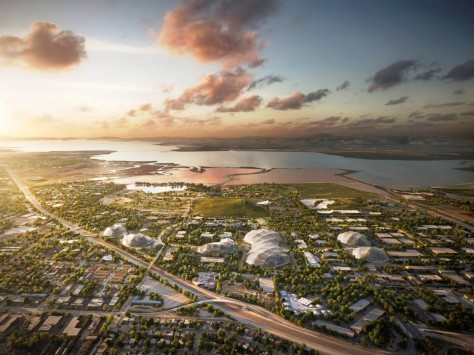Today we’re submitting a plan to redevelop four sites—places where we already have offices but hope to significantly increase our square footage—to the Mountain View City Council.

It’s the first time we’ll design and build offices from scratch and we hope these plans by Bjarke Ingels at BIG and Thomas Heatherwick at Heatherwick Studio will lead to a better way of working. The idea is simple. Instead of constructing immoveable concrete buildings, we’ll create lightweight block-like structures which can be moved around easily as we invest in new product areas.

(Our self-driving car team, for example, has very different needs when it comes to office space from our Search engineers.) Large translucent canopies will cover each site, controlling the climate inside yet letting in light and air.

With trees, landscaping, cafes, and bike paths weaving through these structures, we aim to blur the distinction between our buildings and nature. Of course, this project is about much more than just office space; it’s about doing more with the local community as well. So we’re adding lots of bike paths and retail opportunities, like restaurants, for local businesses.

We also hope to bring new life to the unique local environment, from enhancing burrowing owl habitats to widening creek beds. And we’re committed to do everything we can to save energy—our recent agreement to offset our energy consumption in North Bayshore with renewable energy includes the development of this proposal.

We chose Mountain View for our headquarters 15 years ago because we love the beauty of the bay, the close proximity to great universities, the family-friendly environment and the chance to work in a city at the heart of Silicon Valley. Today, we want to create office spaces that don’t just provide a great home for Google, but which also work for the city that has given us so much. Source by Google Official Blog.

The building’s translucent canopy lifts up to allow the public Green Loop to go through the center of the building, with cafes and local shops on the lower levels. Large, translucent enclosures blur the boundaries between inside and out. These canopies regulate climate, pollution, and sound, while freeing spaces from traditional architectural limitations like walls, windows and roofs.

The canopies along Shoreline Boulevard open onto a public plaza with retail spaces. Along the street, buildings are 2 or 3 stories, with taller areas toward the center of the structures. Within the canopy, building segments operate like furniture—light, tactile and reconfigurable. These segments form small villages where employees can work or relax.

Consolidated parking sits below the building, helping us reach our goal of Net-Zero parking. Once at Landings, visitors can easily connect to the rest of campus through one of several walking and biking paths. At ground level, the environment is newly restored. Employees will be drawn from offices to the outdoors, to work alongside waterways and under trees.

Mountain View residents can walk or ride along green corridors, eat at cafes, shop, play in parks, or work in the public community gardens. By consolidating parking, traffic congestion is reduced in the area, making it safer and more attractive for people to walk and bike.

In place of parking lots and other underutilized sites, we will establish revitalized native ecosystems, including re-oaking and wetlands. This rendering shows the Green Loop, a circuit for bikes and pedestrians that weaves through urban and natural areas. A solar canopy produces energy and also protects bicyclists from the rain. Text and Images by Google +.

